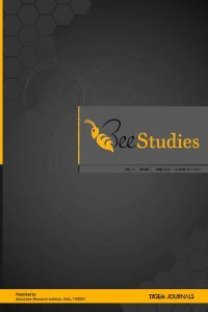The Importance of Plants Belonging to Asteraceae Family as a Pollen Source in Beekeeping
The Importance of Plants Belonging to Asteraceae Family as a Pollen Source in Beekeeping
Asteraceae, Family Ordu, Pollen,
___
- Anonymous, (1979). Çerçeveli (fenni) arı kovanları. Türk Standardları Enstitüsü, TS 3409, Ankara.
- Anonymous, (2005). Bal Arılarında Nosemosis’in Teşhisi. Tarım ve Köyişleri Bakanlığı, Koruma ve Kontrol Genel Müdürlüğü, P(11): 43-44.
- Aytuğ, B., Aykut, S., Merev, N., & Edis, G. (1971). İstanbul Çevresi Bitkilerin Polen Atlası. İstanbul Üniversitesi, Orman Fakültesi, No.1650, İstanbul.
- Baydar, H., & Gürel, F. (1998). Antalya doğal florasında bal arısı (Apis mellifera)’ nın polen toplama aktivitesi, polen tercihi ve farklı polen tiplerinin morfolojik ve kalite özellikleri. Turkish Journal of Agriculture and Forestry, 22(1998), 475–482.
- Bessada, S. M., Barreira, J. C., & Oliveira, M. B. P. (2015). Asteraceae species with most prominent bioactivity and their potential applications: A review. Industrial Crops and Products, 76, 604-615.
- Çobanoğlu, D. N., Felek, İ., & Dündar, O. (2021). Palynological, antioxidant and physicochemical properties of pollen loads from Eastern Anatolia. Bee Studies, 13(2), 31-38. http://doi.org/10.51458/BSTD.2021.15
- Dimou, M., & Thrasyvoulou, A. (2007). Seasonal variation in vegetation and pollen collected by honeybees in Thessaloniki, Greece. Grana, 46(4), 292-299.
- Genç, F., & Dodoloğlu, A. (2011). Arıcılığın temel esasları. Atatürk Üniversitesi, Ziraat Fakültesi, Zootekni Bölümü, Yayın No: 931-341-88, Erzurum.
- Güler, A. (2017). Bal arısı (Apis mellifera L.) yetiştiriciliği, hastalıkları ve ürünleri. Bereket Akademi Yayınları. ISBN: 978-605-84656-3-3
- Karaca, A. (2008). Aydın yöresinde bal arıları (Apis mellifera L.)’nın yararlanabileceği bitkiler ve bazı özellikleri. Adnan Menderes Üniversitesi, Ziraat Fakültesi Dergisi, 5(2), 3966.
- Kaufman, P. B. (1989). Plants their biology and ımportance, Harper-Row Publishert, New York, 757.
- Sawyer, R. (1988). Honey identification. Cardif Academic Press, Wales.
- Sorkun, K. (2003). Rize-Anzer yöresi ballarının mikroskobik analizi. II. Marmara Arıcılık Kongresi, Yalova.
- Sorkun, K., Yılmaz, B., Özkırım, A., Özkök, A., & Gençay, Ö. (2012). Yaşam İçin Arılar. Türkiye Arı Yetiştiricileri Merkez Birliği, Yayın No:5. Önder Matbaacılık Ltd. Şti, Ankara.
- Sorkun, K., & Süer, B. (2013). Bursa’nın Narlıdere, Cumalıkızık, Baraklı yöreleri’nden Apis mellifera L. tarafından toplanan polenlerin morfolojik ve organoleptik analizi. Uluslararası Katılımlı V. Marmara Arıcılık Kongresi, Bursa.
- Webby, R. (2004). Floral origin and seasonal variation of bee collected pollens from individual colonies in New Zealand. Journal of Apicultural Research, 43(3), 83–92.
- Wodehouse, R. P. (1935). Pollen Grains, McGraw-Hill, New York.
- Yaşar, N., Silici, S., Derebaşı, E., Sezgin, O., & Gökçe, M. (2006). Anzer doğal florasında bulunan ballı bitkiler ile balarısı (Apis Mellifera)’nın nektar ve polen toplama aktivitelerinin saptanması. Proje sonuç raporu (TAGEMHAYSÜD-01-14-02-04). Tarım ve Köyişleri Bakanlığı.
- ISSN: 2757-5438
- Yayın Aralığı: Yılda 2 Sayı
- Başlangıç: 2009
- Yayıncı: Arıcılık Araştırma Enstitüsü Müdürlüğü
Ahmet KUVANCI, Şeref CINBIRTOĞLU, Aziz GÜL, Gökhan AKDENİZ, İsmail EREN, Belgin GÜNBEY, Samet OKUYAN, Selim BIYIK, Abdurrahman AYDIN, Gökhan KAVAK, Gülden AYVAZ BAYKAL, Ahmet GÜLER
Abdulraouf AMRO, Mohamed Omar MOHAMED, Ahmad AL GHAMDİ
The Importance of Plants Belonging to Asteraceae Family as a Pollen Source in Beekeeping
Şeref CINBIRTOĞLU, Recep SIRALI
From Bees to Bandages: Exploring Honey Nanoparticles for Effective Wound Management
Determination of Consumers' Consciousness Levels of Consumption of Bee Products
